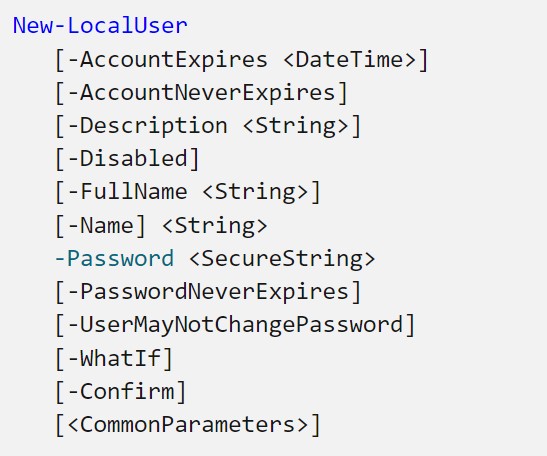User Management
It it possible to create and manage user accounts with Powershell. It is quite essential skill for domain users. In this course we just take a look of user management in a workstation environment.
Get Local Users
You can get all local users with cmdlet Get-LocalUser.
#show all current local users
Get-LocalUser -Name *

You can get all local enabled users with using filtering pipeline Where-Object.
#show all enabled local users
Get-LocalUser -Name * | Where-Object Enabled

Create User
To create a new local user in the Windows operating system using PowerShell, we use the New-LocalUser cmdlet. In the example below the PowerUser with no password will be created. Please note: you have to have run PowerShell as Administrator privileges that you can run the New-LocalUser cmdlet. If not, cmdlet will not work and you will get error message New-LocalUser : Access denied.
$newuser = 'PowerUser'
New-LocalUser -Name $newuser -NoPassword
#show current local user
Get-LocalUser -Name $newuser

There are many parameters for cmdlet New-LocalUser, as you can see:

Remove Local User
Remove-LocalUser deletes local user accounts.
Please, be careful when you trying this cmdlet!
$removeuser = 'PowerUser'
Remove-LocalUser -Name $removeuser
#show current local users
Get-LocalUser -Name Pow*

Local Groups
All the rights and permissions that are assigned to a group are assigned to all members of that group.
Members of the Administrators group on a local computer have Full Control permissions on that computer. Limit the number of users in the Administrators group.
If the computer is joined to a domain, you can add user accounts, computer accounts, and group accounts from that domain and from trusted domains to a local group.
You can get all local groups with the cmdlet Get-LocalGroup.
Get-LocalGroup

You can see users in a local group with cmdlet Get-LocalGroupMember.
In the following example two groups are showed.
#common users
Get-LocalGroupMember -Name Users
#administrators
Get-LocalGroupMember -Name Administrators

More about topics
If you need more information about user management, please familiarize yourself with these:
Local Account
Active Directory in Windows Server